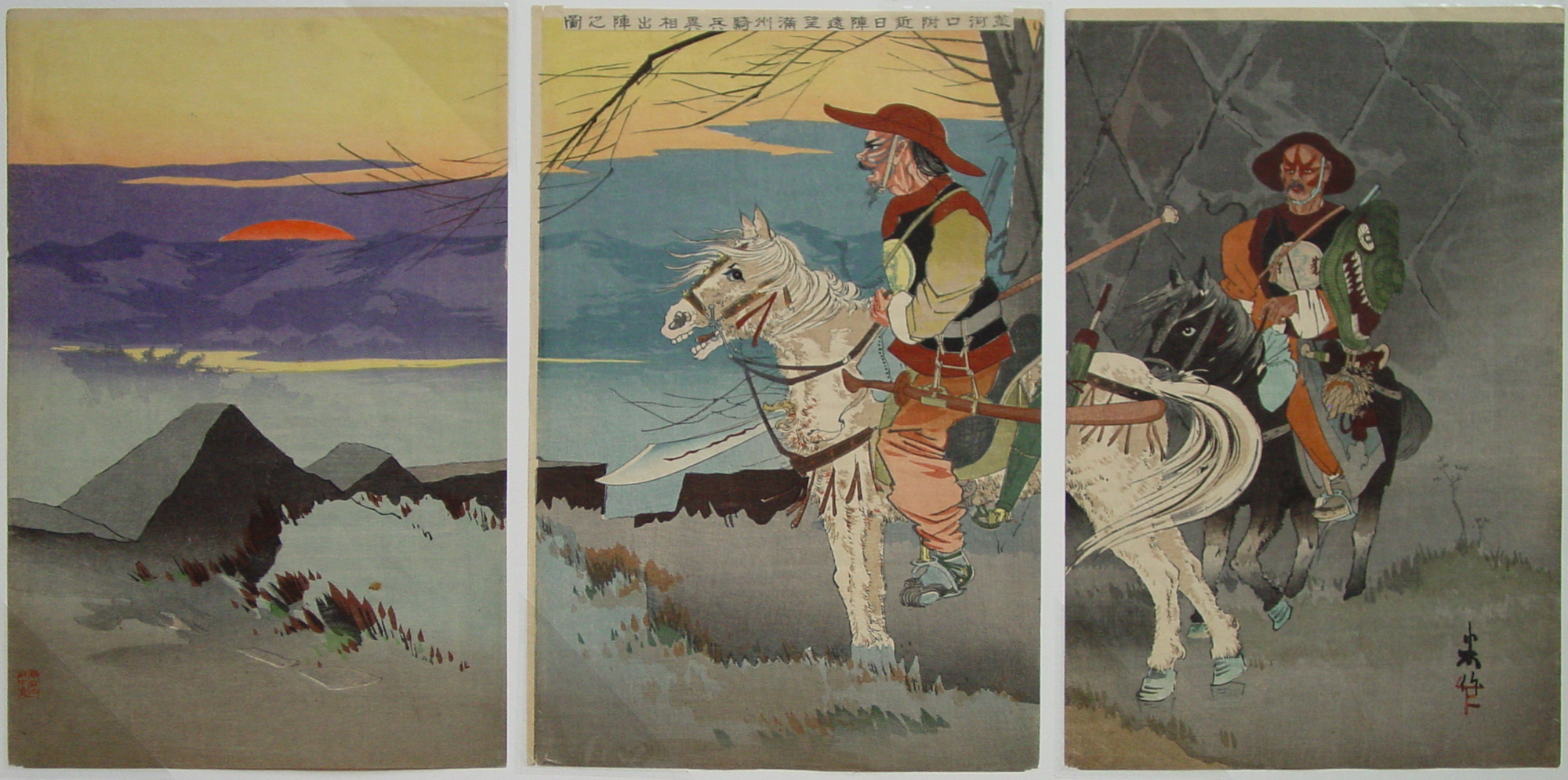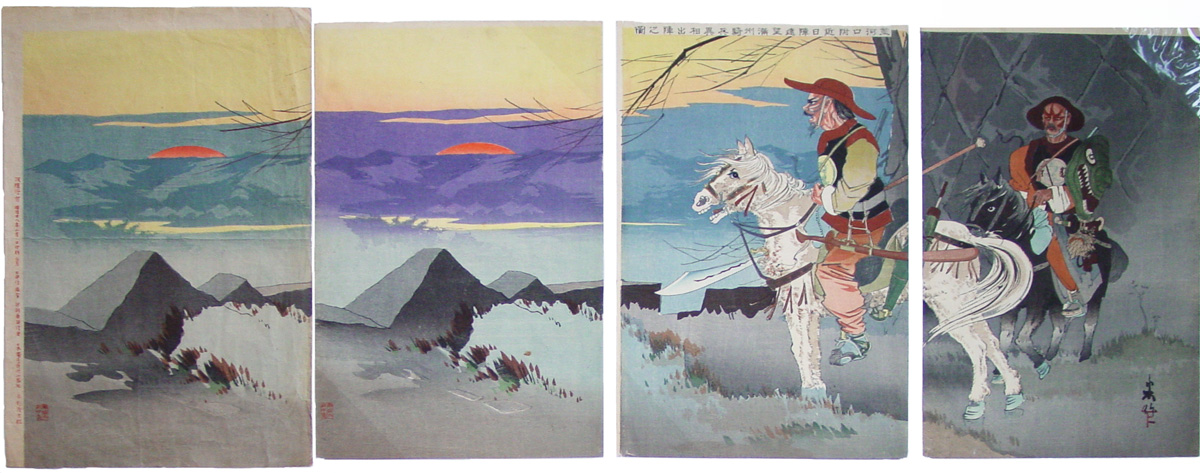About This Print
Source: Impressions of the Front: Woodcuts of the Sino-Japanese War, Okamoto, Shumpei, Philadelphia Museum of Art, 1983, p.31.Mounted Manchurian soldiers survey the Japanese camp in this print. Near Sauhoku, the Japanese encountered a Chinese offensive of elite forces from Manchuria, whose gallantry was legendary. Until then the Chinese had been either on the defensive or in flight, as stated in a Japanese report on this unusual battle: "Up to now the enemy's customary tactic was defense. This time they pretend to take the offensive. It was bizarre. Unlike in the past, they attacked ferociously. We were outnumbered. Like an army of rats and dogs they used a hit-and-run strategy but were no match for the Japanese forces under General Tatsumi, who had a devil's wisdom and a god's bravery."
These Manchurian horsemen played both sides during the war, often working for the side that offered then the most. There was a thin line between their operating as guerrilla fighters for one side or the other and their operating as bandits (honghuzi). These bands continued operating through the Russo-Japanese War (1904-1905) as can be seen this collection's print IHL Cat. #1224 Telegraphic Record of the Russo-Japanese War: Manchurian Mounted Bandits Destroy Railroad.
Source: Japan at the Dawn of the Modern Age – Woodblock Prints from the Meiji Era, Louise E. Virgin, Donald Keene, et. al., MFA Publications, 2001, p. 86
After quickly and victoriously making its way through Korea and occupying Pyongyang, the Japanese First Army pursued the Chinese into Manchuria, crossing the border marked by the Yalu River on October 23, 1894. The troops conquered Hushan, Jiuliancheng, and Fenghuangcheng in quick succession, but upon reaching Sauhoku, they were spied on and attacked by mounted Manchurian soldiers. Some troops did make their way to the pivotal southern Manchurian military center of Haicheng, where they were met by a detachment of the Japanese Second Army, and then on to Nuizhuang, the seaport Yingkou and the Tienchuangtai.
Multiple Printings
This print was purchased with a color mis-matched left panel. I have subsequently acquired another left panel shown below with a better, though far from exact, color match to the center panel. Given that different printers were sometimes assigned different sheets of a triptych to print, color mismatching was not unusual. I suspect this print was reissued a number of times due to popular demand and over the years individual panels may have been reassembled with panels from different printings.Print Details
| IHL Catalog | #81 |
| Title or Description | Illustration of Foreign-looking Manchurian Horsemen on an Expedition to Observe the Japanese Camp in the Distance Near Sauhoku (Caohekou) 草河口附近日陣遠望満州騎兵異相出陣之図 Sōkakō fukin Nichijin enbō Manshū kihei isō shutsujin no zu |
| Artist | Taguchi Beisaku (1864-1903) |
| Signature |  |
| Seal | saku 作 (see above) |
| Publication Date | February 1895 明治廿八年二月 |
| Publisher |  address: 日本橋区葭町二丁目一番地 |
| Engraver |  |
| Printer | suri Nakajima 刷中島 (see seal above) [Nakajima Senseido? (?-?)] |
| Impression | excellent |
| Colors | excellent |
| Condition | good - overall light toning; thinning at corners; small tape stains center of margins on each panel; change in color of mountains and clouds in left panel (not observed in other copies of this print); title removed and pasted onto center panel which is not unusual on senso-e. |
| Genre | ukiyo-e; senso-e (Sino-Japanese War) |
| Miscellaneous | |
| Format | vertical oban triptych |
| H x W Paper | 13 3/4 x 9 1/8 in. (35 x 23.2 cm) each sheet |
| Literature | Impressions of the Front: Woodcuts of the Sino-Japanese War, Okamoto, Shumpei, Philadelphia Museum of Art, 1983, pg. 31, pl. 40; Japan at the Dawn of the Modern Age – WoodblockPrints from the Meiji Era, Louise E. Virgin, Donald Keene, et. al.,MFA Publications, 2001, p. 93, pl. 45; Conflicts of Interest: Art and War in Modern Japan, Philip K. Hu, et. al., Saint Louis Museum of Art, 2016, p. 139, pl. 46. |
| Collections This Print | Smithsonian National Museum of Asian Art S2003.8.54; Museum of Fine Arts, Boston: Jean S. and Frederic A. Sharf Collection 2000.255; Philadelphia Museum of Art 1976-75-10; National Museum of Japanese History H-22-1-21-123; Ackland Art Museum, University of North Carolina at Chapel Hill 2016.5.4; Hakodate City Central Library 1114234097-0001, 0002, 0003; Saint Louis Museum of Art 116:2010a-c |
3/20/2020



